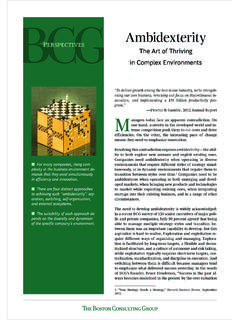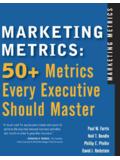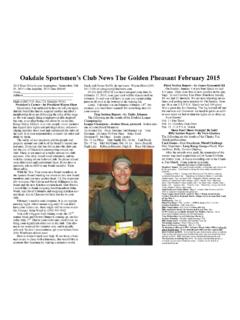Transcription of Assuming Leadership: The First 100 Days - BCG
1 PerspectivesAssuming leadership : The First 100 Days401 Assuming Jan 03 1/9/03 2:50 PM Page 1 Assuming leadership : The First 100 DaysDuring his First 100 days in office, Pres-ident Franklin D. Roosevelt sent 15 mes-sages to Congress, guided 15 major laws toenactment, delivered 10 speeches, held pressconferences and cabinet meetings twice aweek, conducted talks with foreign heads ofstate, sponsored an international confer-ence, made all the major decisions in domes-tic and foreign policy, and never displayedfright or panic and rarely even bad temper. Arthur M. Schlesinger Jr.,The Age of Roosevelt:The Coming of the New Deal Most of our readers will step into a new jobat some point in the next five years. Many willbe recruited or promoted to the top post intheir companies.
2 Their performance duringtheir First 100 days in office will be crucial:friends and foes alike will be watching forsigns of long-term success or failure. To comeeven close to filling FDR s shoes today, leaderswill need to be highly visible, pragmaticallyoptimistic, action oriented, and willing to lis-ten to others Assuming Jan 03 1/9/03 2:50 PM Page 3We asked 20 CEOs to tell us about their firstmonths in office: what they intended to do,what they did, what they regretted doing, andwhat they regretted not doing. We heardsome good stories and received a lot of practi-cal advice, such as Diagnose First , decide second. Follow your instincts. Take notes, then prioritize and act. Understand that as the head person,you have only three topics: people, strat-egy, and values.
3 Everything else is secondary. Pick a kitchen cabinet of people youtrust and use them for problem solving. Then we asked the CEOs to consider theirown advice and come up with the agenda theywould follow if they could start over in theirjobs today. Ten actions were consistently mentioned. 1. Assess the company s leadership teamand complete your initial round of changeswithin the First 30 group is likely tohave a greater impact on the business thanthe team of direct reports that you puttogether. When forming that team, it makessense to add a few trustworthy outsiders whowill be able to help change the culture andcreate a sense of urgency. But don t discountold-timers.
4 They carry the memory of the401 Assuming Jan 03 1/9/03 2:50 PM Page 4company, have years of experience, and areusually more interested in the business thanin their own choose the right people, you need to dosome research and then be willing to act onyour intuition. Review each candidate srecord with the head of human resources,look at the data on his or her performance,and hold personal interviews with the mostpromising players in order to develop a senseof whom you can rely on. Your assessmentshould include the basics of strategy: Do theyunderstand market turns, competitive vulner-ability, and cost opportunities? What addi-tional skills will they need and how quicklycan they acquire them?
5 The countdown to theend of the honeymoon period begins with theannouncement of your appointment in theWall Street Communicate your vision of a bettercompany and make sure employees under-stand how you will get may be tooearly for specific details about your plans, butyou should convey the basic values that willserve as your framework for making futuredecisions. Employees need to understand thatyou are sincere and competent. Answer ques-tions honestly and don t promise is also the time to be clear about yourmanagement style how you will treat others401 Assuming Jan 03 1/9/03 2:50 PM Page 5and how they should treat you. Doing so willsave everyone from wasting valuable energytrying to figure out how to please you.
6 3. Meet ten salespeople on the frontlineand ask them what the company should up the chain of commandwill introduce new sources of people know the business insideand out. They hear all of the customers com-plaints, know where all of the quality prob-lems are, and are often able to predict adownward trend before the financial peoplecan. Ask the salespeople what you can do tomake their working lives better and what partsof their work give them satisfaction and needto be preserved. Honest engagement now canset the stage for receiving valuable informa-tion for years to Meet with ten major customers for anoutside-in view of the are an invaluable means of gather-ing anecdotal information about current performance, business trajectories, and anyindirect competition that may be out , bringing your senior peopletogether with the senior people in your customers companies can help forge strongbonds.
7 Listen carefully, receive the feed-back graciously, and be sure to act on valu-able ideas. 401 Assuming Jan 03 1/9/03 2:50 PM Page 65. Pay attention to personal projected on a 50-foot screen by avideo camera. Every move you make as aleader will be subject to discussion and inter-pretation. That includes how early you arrivefor work, how you relate to people in the hall-way, how you allocate your time, and howthoroughly you prepare for meetings. This isa good time to signal the strength of yourcommitment by identifying one or two aspectsof the company culture that you want tochange and then changing them quickly. Butbeware of setting precedents in solving prob-lems today that limit your range of options forfinding solutions tomorrow.
8 6. In a turnaround situation, stop all discre-tionary spending until you have determinedyour business is still king. It iscritical to husband resources for major initia-tives. If a business isn t performing well, youshould rethink all of it including advertis-ing, new-product development, and the needfor major operational changes. Every organi-zation s budget supports a number of itemsthat can be reduced or eliminated at no often, the most important projects lacksufficient resources because money is beingspent on less worthy causes. Create a shortlistof priorities and make sure they are wellfunded and carefully tracked. 401 Assuming Jan 03 1/9/03 2:50 PM Page 77. Learn how the business creates prof-itability: understand leverage points anddevelop simple reporting where the money comes from and whereit goes can be quite difficult.
9 And given theclose scrutiny executives are subjected totoday, it will be necessary to know all of thecompany s revenue-recognition often delegate this task to the can be a big mistake. A firsthand under-standing of how the revenue side of the busi-ness works will help uncover hiddenshort-term upsides or squirreled-awayreserves. It will also help identify the key indi-cators that employees and management lookfor in assessing the business. There are profitengines inside every organization find yoursand accelerate their Understand the problems that reside onthe balance sheet and communicate get one chance to erase the mis-takes of your predecessors. Identify and dealwith these legacy issues immediately.
10 Unpleas-ant surprises obsolete inventory, insufficientwarranty reserves, excessive goodwill, unre-solved customer disputes, and festering litiga-tion have a way of hiding behind thenumbers. Critical off-balance-sheet commit-ments also need to be understood, includingpromises made by the previous managementteam. A good rule of thumb is to expose401 Assuming Jan 03 1/9/03 2:50 PM Page 8everything and devise conservative principlesfor the future. 9. Develop the ability to detect hiddenthreats and opportunities. Apply Band-Aidswhere necessary. Keep a running list of hits might include running moreprofitable product promotions, negotiatingan expanded agreement with a key customer,curtailing new-product development in weakcategories, and launching a comprehensiveproductivity initiative to match a competitor slower costs.















